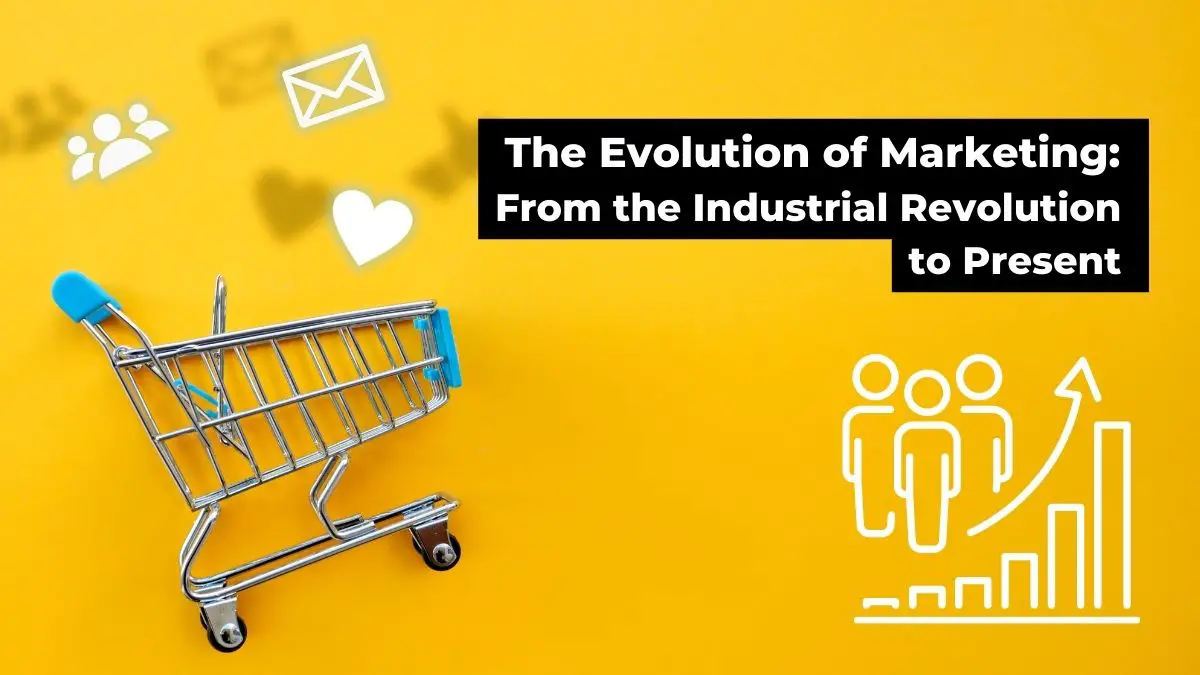Trying to find a solid date to begin the timeline for the evolution of marketing is completely subjective.
The concept of marketing can date all the way back to when commerce first began and traders had to come up with unique ways to promote their goods by catching the attention of people passing by. This time period for marketing evolution is considered the Simple Trade Era and dates from prehistoric times leading up to the Industrial Revolution.
Let’s explore the evolution of marketing by looking at certain eras and marketing campaigns that completely changed the landscape of marketing as we know it today and a good place to start is the birth of the mass production era.
The Industrial Revolution (1760-1860): The Birth of Mass Marketing
As we time travel back to the period between 1760 and 1840, we find ourselves in the Industrial Revolution. This is when marketing evolution really starts to make its mark.
This was a time when the world underwent major transformations with innovations like the steam engine and the advent of mechanization.
Factories sprouted, facilitating the mass production of goods, a concept previously unimaginable. But with mass production came a new puzzle – how to achieve mass sales? This gave birth to the mass marketing era – the first major milestone in the evolution of marketing.
Let’s consider the case of Josiah Wedgwood, a British pottery tycoon, who was ahead of his time. In the 1770s, Wedgwood recognized the untapped potential of the burgeoning middle-class market.
His genius lay in creating techniques to mass-produce high-quality pottery, transforming it from a luxury good to a middle-class staple. But Wedgwood’s innovation didn’t end there.
He introduced the marketing concept of money-back guarantees which is an essential part of customer satisfaction to this day.
He also introduced the marketing concept of free delivery, which is also an essential part of the modern marketing mix used today.
His ultimate marketing triumph came when he earned the endorsement of Queen Charlotte, leading his products to be dubbed as “Queen’s Ware.” This early instance of influencer marketing helped him carve a compelling brand image that resonated with his middle-class consumers. His techniques proved to be a roaring success, and the Wedgwood brand continues to thrive, over 250 years later.
The Production Era (1860-1920): Marketing Evolution in Efficiency
The Production Era, also known as the Production-Oriented Era, typically dates from the time of the Industrial Revolution in the late 1800s until about the 1920s or 1930s. It also marks an important time period in the evolution of marketing.
During this time, a business’s primary focus was on manufacturing and production efficiency. The prevailing thought was that a good product would sell itself, or in other words, “If you build it, they will come.” Businesses operated under the assumption that consumers were primarily interested in obtaining products that were affordable and functional.
An iconic example from this era is Henry Ford and his revolutionary Model T automobile. Ford introduced the assembly line method to his factories, leading to mass production of the Model T. This drove down costs significantly, making the automobile affordable to many American households for the first time. Ford famously said of the Model T, “Any customer can have a car painted any color that he wants so long as it is black.”
It’s important to note that while this approach led to unprecedented economic growth and consumer access to goods, it largely ignored the importance of consumer choice and marketing. The shift away from this era began as competition increased and companies had to start differentiating themselves not just on price, but on other factors like quality, features, and brand reputation.
The Sales Era (1920-1950): The Rise of Branding and Advertising
The early part of the 20th century was characterized by escalating competition, expanding markets, and a desperate need for companies to distinguish themselves – creating a new landscape for the evolution of marketing.
While the sales era marks a period where brand loyalty was starting to hit the spotlight, it was also a time period where many businesses focused heavily on selling without truly understanding the consumers’ needs.
During the Sales Era, supply often outpaced demand due to the significant advancements in production techniques that had been developed in the earlier Production Era.
As a result, the focus shifted from manufacturing and production to selling and promoting. Sales tactics, persuasion, and personal selling were at the forefront.
Business managers were primarily interested in selling whatever they produced, placing more importance on selling techniques rather than matching products to consumer needs.
It was also during this time that household brands like Coca-Cola, Campbell Soup, and Kellogg’s began to craft distinct identities, emotionally resonating with consumers on a deeper level.
Let’s look at Coca-Cola.
In the early 1900s, Coca-Cola, with its unique logo and refreshing promise, began to create a brand that went beyond simply offering a sweet, fizzy beverage. It launched an aggressive advertising campaign with memorable slogans such as “Drink Coca-Cola – Delicious and Refreshing.” Coca-Cola even shaped our modern perception of Santa Claus through their holiday advertising campaign in the 1930s, demonstrating the extraordinary influence of branding.
As we journey through the rest of the 20th century, we’ll witness marketing evolve in tandem with technology and changing consumer behaviors. We’ve only skimmed the surface, so stay tuned – the evolution of marketing is about to get even more exciting!
The Marketing Company Era (1940-1970): The Broadcast Boom and Rise of TV Advertising
The Marketing Company Era is generally considered to have begun in the second half of the 20th century, around the 1950s and 1960s.
This era marked a shift from sales-oriented strategies to a comprehensive marketing approach – taking on a more strategic approach with the evolution of marketing.
Businesses began to realize that in order to be successful, they had to be customer-oriented and all company functions had to be integrated to serve this goal.
Also known as the Marketing Department Era or Marketing Orientation Era, this period saw the rise of branding and positioning as key marketing strategies.
Companies began to focus not just on selling products or services, but on creating a brand identity that would resonate with their potential customers.
For example, Nike emerged during this era and successfully positioned itself not just as a seller of athletic shoes, but as a lifestyle brand synonymous with athleticism, performance, and cool – directly speaking to the customer needs.
In addition to branding, companies during this era also started leveraging more sophisticated market research techniques to better understand consumer behavior and preferences, enabling them to tailor their products and marketing strategies to better meet consumer needs.
One could argue that we’re still in the Marketing Company Era, albeit with many advancements and changes brought about by technological progress and changing consumer behaviors. The core principle of putting the customer at the center of a business’s strategy, however, remains as relevant as ever.
A shining example of this era is the soap company, Procter & Gamble. In the early 1950s, P&G started producing daytime dramas to promote their products, including soaps, to a mostly female audience. These serials were broadcasted during the day when housewives were likely to be home, leading to the birth of the term “soap operas.” This strategy elevated brand storytelling to a whole new level. P&G’s unique approach transformed the brand from just another name on the supermarket shelf into an essential part of consumers’ daily lives.
Relationship Marketing Era (1980-2000): Digital Revolution and Relationship Marketing
As we zoom ahead to the late 20th century, we see the dawn of the digital revolution. With the rise of personal computers and the internet, marketers began to understand the potential of these technologies to reach customers in more personalized ways through the use of digital marketing strategies.
Digital marketing efforts, such as email marketing, grew in popularity, and data began to play an increasingly crucial role in shaping marketing strategies.
This is when the relationship marketing era began and it started to gain prominence in the late 1980s and early 1990s.
The term “Relationship Marketing” was first widely popularized in 1983 by Leonard Berry, a business professor who emphasized the importance of customer retention in service industries. It was during the 1990s that this approach became more broadly adopted across various industries as marketers began to recognize the value in creating and maintaining long-term relationships with customers.
This era saw a shift from transaction-based marketing, which focuses on individual sales, to relationship marketing, which emphasizes customer satisfaction and retention.
Amazon, founded in 1994, stands as a brilliant example of a company that leveraged this digital revolution. Amazon’s unique selling proposition was its ‘Earth’s Biggest Bookstore’ strategy, offering millions of books online when traditional bookstores could only stock a fraction of that. However, Amazon’s game-changing move was its use of data to personalize the customer experience. By tracking customer behaviors and preferences, Amazon could provide personalized recommendations, leading customers to discover and purchase more products. This level of personalization, unthinkable in a pre-digital era, gave Amazon an edge and has been a key factor in its astounding success.
These were pivotal times in the evolution of marketing. But hold onto your hats, folks. The dawn of the 21st century will bring in a wave of social media and mobile marketing that will once again redefine the game! Stay tuned!
Early 21st Century (2000-2010): The Rise of Social Media
As the digital age continued to evolve in the early 21st century, a new phenomenon was taking shape: social media. Platforms like Facebook, Twitter, and LinkedIn started to connect people in unprecedented ways and digital marketing and social media marketing really started to take off.
The ability to take advantage of social media platforms offered brands an opportunity to engage directly with consumers, creating two-way conversations that had never been possible before and paved the way for new digital marketing concepts.
Starbucks, a well-established brand by this time, was one of the first companies to truly understand the potential of digital marketing. Starbucks launched its “My Starbucks Idea” campaign in 2008, which allowed customers to share their ideas for improving the Starbucks experience. This digital marketing strategy not only helped Starbucks create an engaged online community but also provided valuable insights that helped shape the company’s product offerings.
The Present Day (2010-Present): Mobile Marketing and Influencer Marketing
Fast forward to the present day, and we’re now firmly in the era of mobile and influencer marketing. The widespread use of smartphones has resulted in consumers being constantly connected to the internet. Brands have capitalized on this, with digital marketing becoming a key strategy to reach customers in real-time, wherever they are.
Take Coca-Cola, for example. The company’s “Share a Coke” campaign launched in 2011, which involved replacing the traditional Coca-Cola logo on bottles with common names, proved highly effective on mobile. Consumers were encouraged to share pictures of their personalized Coke bottles on social media, creating an effective and viral mobile marketing campaign.
Moreover, the rise of influencers on platforms like Instagram and YouTube has given birth to influencer marketing. Brands collaborate with popular personalities, who have built loyal followings on these platforms, to promote their products or services.
Fashion Nova, a relatively young brand, has skyrocketed to success primarily through its influencer marketing strategy. By collaborating with influencers, including mega-stars like Cardi B, the company has been able to reach a large and engaged audience, leading to significant brand growth in a short span of time.
As we move forward, the marketing landscape will continue to evolve, with new technologies and platforms likely to emerge. The challenge for marketers is to stay ahead of these changes and find innovative ways to connect with consumers.
The Future (2020 and Beyond): AI, VR, and AR Marketing
Looking ahead, one cannot discuss the future of marketing without mentioning Artificial Intelligence (AI), Virtual Reality (VR), and Augmented Reality (AR). These cutting-edge technologies are poised to revolutionize marketing even further, offering an incredibly immersive, personalized, and interactive experience to consumers.
What will marketing evolution look like with all these new and advanced technologies?
AI, for instance, is already being used in marketing to provide personalized recommendations. Think about Netflix, which uses AI to analyze your viewing history and suggest content you might like. Or Amazon, which has been using AI for years to recommend products based on your browsing and purchase history. But the future holds even more promise. With advancements in AI, brands might soon be able to predict consumers’ needs before they even realize them themselves.
On the other hand, VR and AR offer unique ways for brands to engage with consumers. Brands like IKEA and Sephora have been pioneers in this space. IKEA’s AR app, IKEA Place, allows customers to virtually place furniture in their homes to see how it would look and fit, while Sephora’s Virtual Artist app allows customers to virtually try on makeup, helping them make purchase decisions without stepping foot in a store.















0 Comments